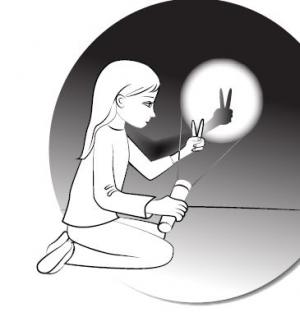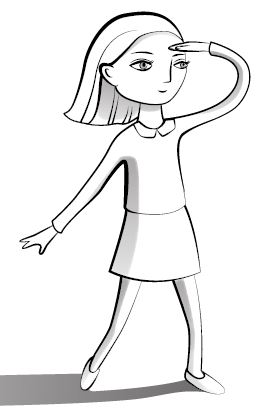NSTA Press
On the Having of Wonderful Ideas About Science
By Claire Reinburg
Posted on 2020-03-26
Guest Blogger Page Keeley
Science is about making sense of our natural world, and this is something that children naturally do long before they begin school. Children acquire information from many sources: interacting with their environment, conversing with their families and friends, and picking up ideas in books and from the media. Children are constantly taking in new information and trying to make sense of it. For elementary-age children, parents and teachers can be guides and facilitators in supporting children in their wonderings and in helping them develop their ideas about science. In this video, I introduce you to tools we have developed in the Uncovering Student Ideas in Science series that you can use at home or through online learning to help students get their ideas out and share them as they explore phenomena and science concepts.
Learning About Light and Shadows
So let’s explore shadows with two probes called “Shadow Size” and “When Is My Shadow the Longest?” The first probe, “Shadow Size,” helps children develop ideas about how light interacts with objects and forms shadows. The second probe, “When Is My Shadow the Longest?”, helps children recognize how shadows change throughout the day based on where the Sun is. These probes are from Uncovering Student Ideas in Primary Science, Volume 1. Use these downloadable sheets or view them on a computer/ tablet to start a conversation with the children. How would you make the shadow larger if you were the child in the illustration? When do you think your shadow outside will be the longest—early morning, late morning, or noon?
Tips for Talking With Children About the Probes
The activities I discuss below illustrate how probes are used in three steps:
- Activate children’s preconceptions.
- Engage them in experiences during which they acquire evidence and new information.
- Have them use what they discovered to revisit and revise their initial thinking.
Throughout this process, it’s important that parents and teachers focus on letting children get their ideas out. Try not to comment on whether an idea is accurate or “good.” Don’t correct children when they share a misconception. Instead, use comments like “tell me more about that” or “what else do you think about ___.” These open-ended prompts can invite more detailed discussion.
Explore Shadow Size
 Pull out a flashlight and a few paper cutouts of simple shapes like a star, heart, or triangle affixed with tape to a pen or craft stick. In a darkened room, let children explore how to make the shadow larger or smaller. Does their observation match their prediction? Guide them in looking for cause-and-effect relationships such as “when I move the flashlight closer to my paper shape, the shadow _____; when I move the flashlight farther away from my paper shape, the shadow ____.” Challenge the children to make the largest shadow they can with their paper shape and then make the smallest shadow. Ask the children to explain what makes a shadow. What pattern do they notice? After exploration and discussion with the children, revisit the probe again, providing them an opportunity to use their observations to explain the phenomenon.
Pull out a flashlight and a few paper cutouts of simple shapes like a star, heart, or triangle affixed with tape to a pen or craft stick. In a darkened room, let children explore how to make the shadow larger or smaller. Does their observation match their prediction? Guide them in looking for cause-and-effect relationships such as “when I move the flashlight closer to my paper shape, the shadow _____; when I move the flashlight farther away from my paper shape, the shadow ____.” Challenge the children to make the largest shadow they can with their paper shape and then make the smallest shadow. Ask the children to explain what makes a shadow. What pattern do they notice? After exploration and discussion with the children, revisit the probe again, providing them an opportunity to use their observations to explain the phenomenon.
 Children can also explore shadows formed by the interaction of light from the Sun with an object. After making a prediction and sharing their reasoning, take children outside on a sunny day and have them observe their shadow at the different times mentioned in the probe. Pull out the chalk and mark where they’re standing and where their shadows end. Without looking directly at the Sun, guide children in noting where the Sun is in the sky (low, higher, overhead) in relation to their shadow measurement. Encourage children to describe the pattern of shadow length. Guide them in completing cause-and-effect statements about the length of shadows such as “When the Sun is lower in the sky, my shadow is ______; when it is higher in the sky, my shadow is ______.” Using their observations as evidence, children can revisit the probe and revise their initial explanation.
Children can also explore shadows formed by the interaction of light from the Sun with an object. After making a prediction and sharing their reasoning, take children outside on a sunny day and have them observe their shadow at the different times mentioned in the probe. Pull out the chalk and mark where they’re standing and where their shadows end. Without looking directly at the Sun, guide children in noting where the Sun is in the sky (low, higher, overhead) in relation to their shadow measurement. Encourage children to describe the pattern of shadow length. Guide them in completing cause-and-effect statements about the length of shadows such as “When the Sun is lower in the sky, my shadow is ______; when it is higher in the sky, my shadow is ______.” Using their observations as evidence, children can revisit the probe and revise their initial explanation.
Children love to talk about their ideas, and you’ll find that the research-based questions in the Uncovering probes can help you encourage that conversation and foster a strong desire to learn about science and figure things out.
Background for the Parent and Teacher
The “Shadow Size” probe for teachers and parents provides background information and context on the purpose of the probe and the research summaries of the commonly held ideas in this area of science. The probe is designed to elicit young children’s ideas about how light interacts with an object to form a shadow. It helps reveal children’s ideas about the size of a shadow in relation to its distance from the light source. However, sometimes children’s preconceptions can affect how they think about a phenomenon. For example, one study found that some children think the size of a shadow depends solely on the size of the object, failing to recognize the role of light.
The “When Is My Shadow the Longest?” probe for teachers and parents is designed to find out children’s ideas about shadows and how they think shadows change from sunrise to noon. Research has found that some children think their shadow stays the same shape and size throughout the day. The background information also provides suggestions for further instruction. For example, you can extend the probe by having children make measurements throughout the day.
As the renowned educator and scholar Eleanor Duckworth said in her classic book, The Having of Wonderful Ideas (Teachers College Press, 2006), “The more we help children to have their wonderful ideas and to feel good about themselves for having them, the more likely it is that they will someday happen upon wonderful ideas that no one else has happened upon before.” These probes provide an opportunity for children to share their wonderful ideas in a nonjudgmental way and to discover for themselves when to modify their thinking.
Try It and Share With Us
Try out these probes and share with us what you did and how the conversations went! Share your comments below, or tweet your photos and comments @NSTA and @CTSKeeley. We’d love to hear about your children’s wonderful ideas about shadows.
Additional Resources
Explore more resources on this topic from NSTA:
“Formative Assessment Probes: Talking About Shadows,” by Page Keeley. Science and Children.
“My Shadow” and “Shadows on My Playground,” by William Ritz and William Straits, in A Head Start on Science, Second Edition: Encouraging a Sense of Wonder, NSTA Press.
“Teaching Through Trade Books: Sunrise, Sunset, and Shadows,” by Christine Royce. Science and Children.
“Sunrise, Sunset,” by Emily Morgan and Karen Ansberry, from Teaching Through Trade Books by Christine Royce, Karen Ansberry and Emily Morgan, NSTA Press.
Next Time You See a Sunset, by Emily Morgan, NSTA Kids, and La proxima vez que veas una puesta del sol, by Emily Morgan.
Dark as a Shadow, by Larry Lowery, NSTA Kids. [Read an excerpt]
The Amazing Light Show, NSTA Ebooks+ Kids.
“Sunrise, Sunset: Using Personal Observations to Understand Changing Sun Patterns From an Earth Perspective,” Science Scope.
Disclaimer: The views expressed in this blog post are those of the author(s) and do not necessarily reflect the official position of the National Science Teaching Association (NSTA).


